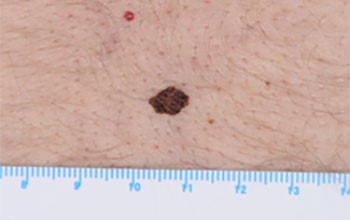
How to check your skin
It is important to regularly check your skin to ensure that you are aware of any changes. Performing a skin check is easy if you know what to look out for. Use the ABCDE guide below, and make it a habit to examine your skin, and your partner’s skin, at the beginning of every season.
HOW TO CHECK YOUR SKIN

STEP ONE: TORSO
Examine body front and back in mirror.
Lift your arms to check your face, head, neck, armpits and the sides of your body.
Lift each breast (if applicable) to check the underside.
With your back to a full-length mirror, use a handheld mirror to check the back of the shoulders, back, upper arms and lower back.

STEP TWO: ARMS & HANDS
Look at the hands, both the backs and the palms.
Check between the fingers and under the fingernails.
Bend your elbows. Check wrists and forearms, both the back and front.
Use a large mirror to check all sides of the upper arms, including the underside.

STEP THREE: LEGS & FEET
Check the front of the legs.
Use a full length and a hand mirror to check the legs, backs of the legs, buttocks and feet.
Sit down, crossing one leg over the other, to check the front and sides of the legs, ankles feet, between toes and under toenails.
Cross the other leg over and repeat.
Check the soles of the feet.

STEP FOUR: FACE, HEAD & NECK
Systematically check your face, nose, lips, mouth, and ears.
Use a comb to part your hair and check your scalp.
Use a handheld mirror to check behind your ears and neck.

STEP FIVE: BUTTOCKS & GENITAL AREA
Finally, check your back, buttocks, and genital area with a hand mirror.
The ABCDE is a simple acronym or classification tool dermatologists use to distinguish a superficial spreading melanoma from a normal mole: Asymmetry, Borders, Colour, Diameter and Evolving.
It provides a simple way to think about what you are looking for. Most melanomas will display at least one of the ABCDE criteria. Sometimes benign moles may show some of the ABCDE features too. If you, or your partner, have any concerns about a mole, see your doctor as soon as possible.
ASYMMETRY
Unlike most benign moles, melanoma is often asymmetric. This means that if you draw a line through the middle of the mole, the two sides do not mirror one another.

Example of a symmetric benign mole.

Example of an asymmetrical melanoma.
BORDER
Benign moles have smooth, even borders. Melanomas often have irregular, ill-defined borders.

An example of a mole with easily identifiable borders.

An example of a mole with difficult to distinguish borders.
COLOUR
Benign moles are usually a single shade – often a single shade of brown – whereas melanomas often contain multiple colours- including brown, black, pink, red, white, or purple.

This benign mole is a single shade of brown

This melanoma contains multiple colours – a melanoma warning sign.
DIAMETER
Benign moles are usually less than 6mm in diameter (<6mm or 1/4”). Melanomas are often more than 6mm in diameter (>6mm or 1/4”).

An example of a mole less than 6mm.

An example of a mole larger than 6mm.
EVOLVING
When you check your skin, or your partner’s skin, look out for any signs of change in appearance. Benign moles usually do not change over time whereas melanomas often grow in shape or change in height. If you notice a change in shape, colour or height of a mole see your doctor immediately. Other changes to be concerned about include bleeding, itching, crusting, new moles developing after the age of 30, or if there is a sore that does not heal after a few months.

An example of change in a malignant melanoma. As you can see, this mole has more than doubled in size over the period it was photographed. Image source: https://servingnature.blogspot.com.au/

